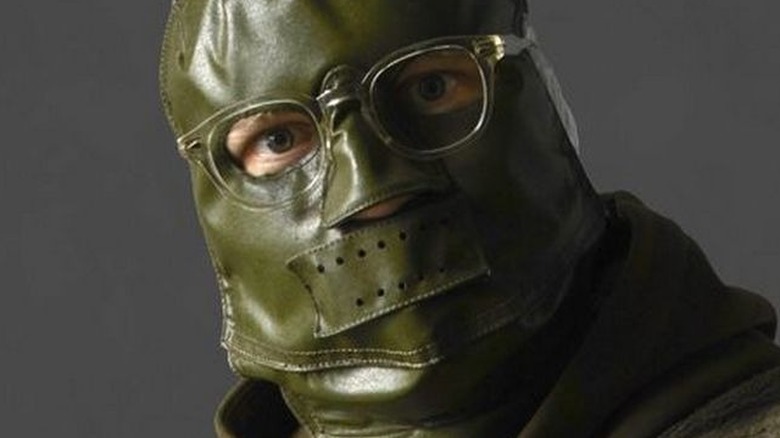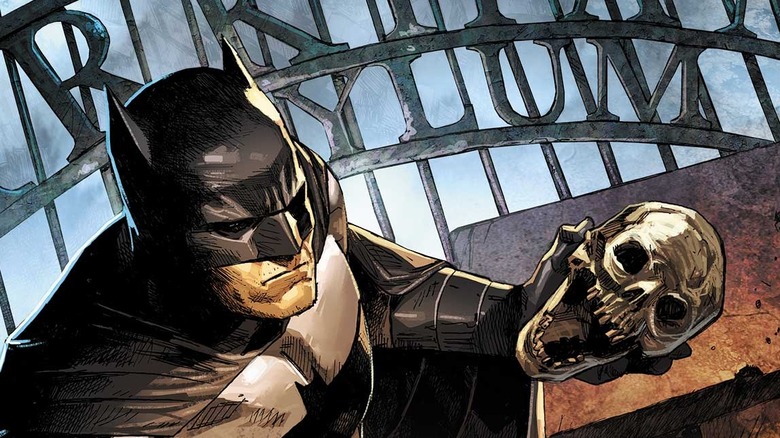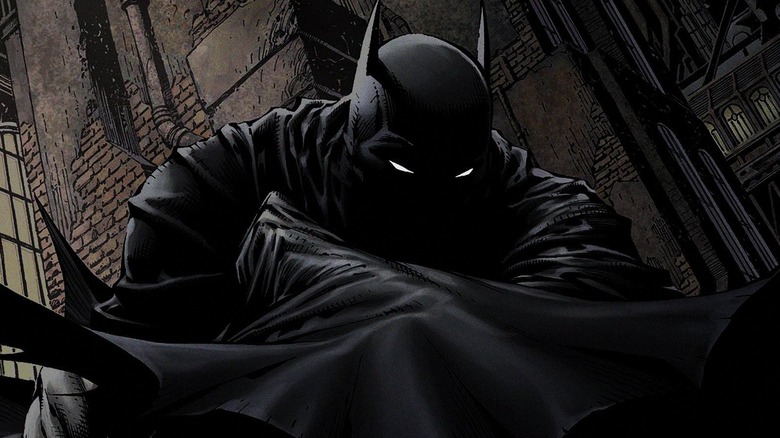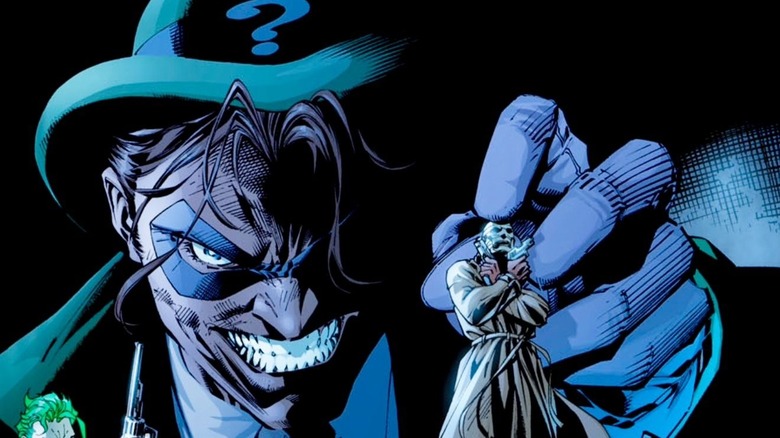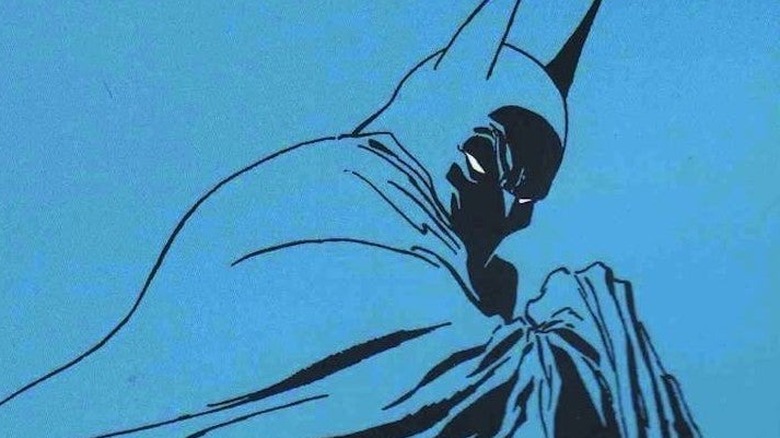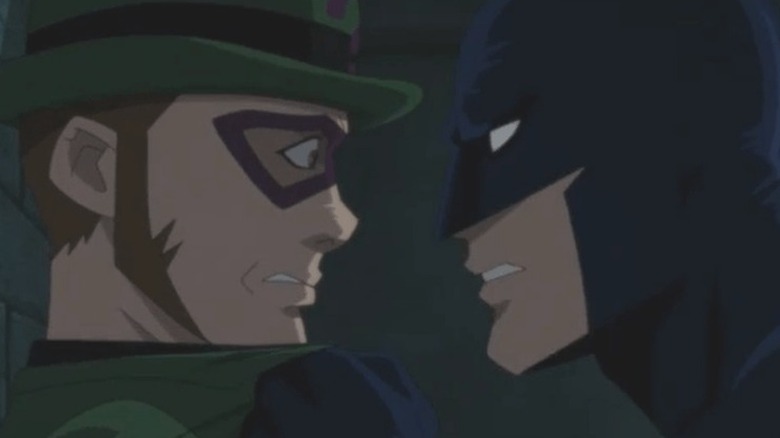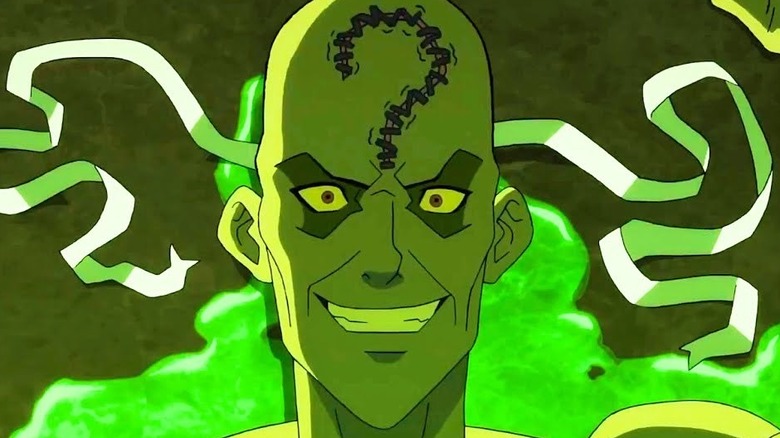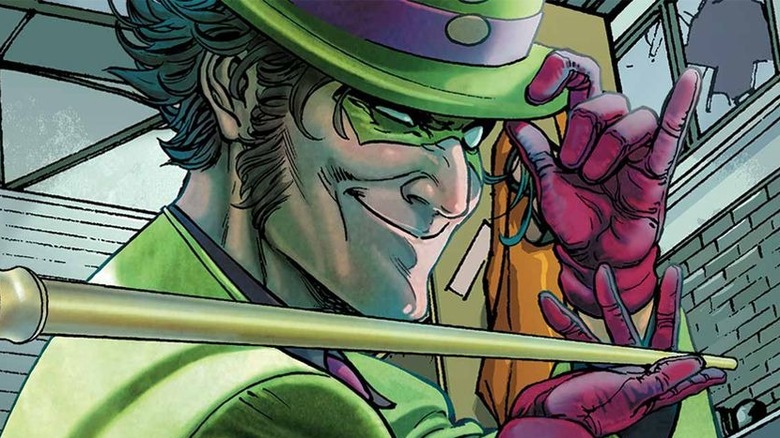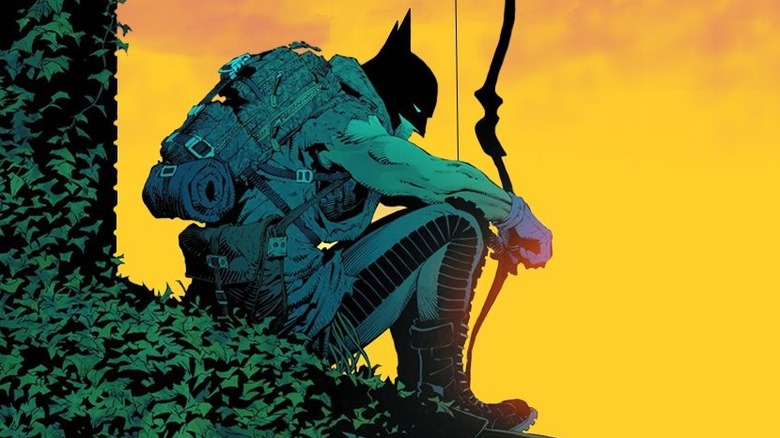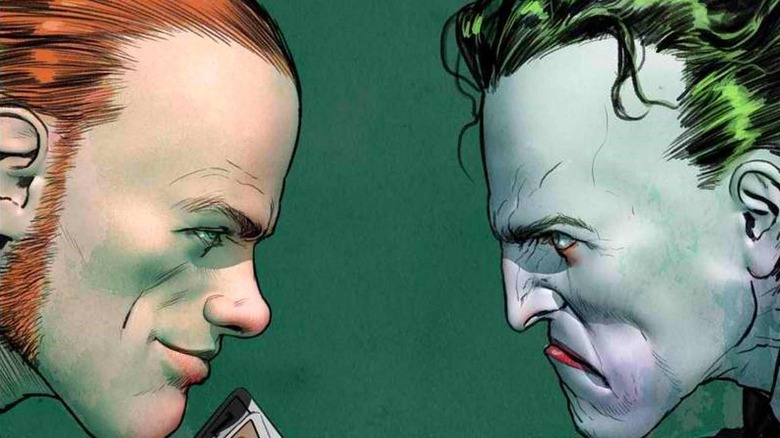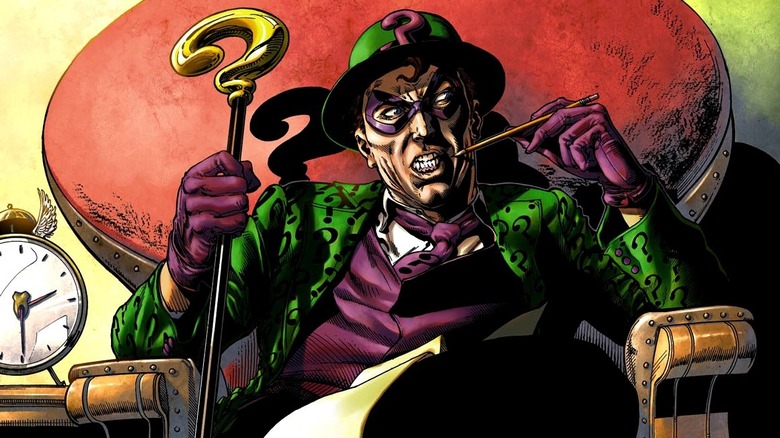Batman's History With The Riddler Explained
We're finally on the eve of Matt Reeves's "The Batman," the character's first solo outing since the halcyon days of Christopher Nolan's "Dark Knight" trilogy. In that decade-long gap, creative visions for the Caped Crusader have come and gone, finally settling on Reeves's somber, cerebral Batman. This new, even-darker knight comes as part of a package deal, including a shadowy Gotham, sinister tone, and perhaps his deadliest villain yet – the Riddler.
The Riddler is the perfect fit for the new film, matching Robert Pattinson's self-reflective, analytic, almost Sherlock Holmesian Batman wit for wit. Their intellectual showdown promises to be an elaborate, high-stakes game of chess with Gotham as the board and its citizens as the pieces. Even casual fans will be aware that "The Batman" will be far from the first war between these two. Their rivalry spans decades, and even graced –- or disgraced, depending on your opinion –- the big screen once previously in "Batman Forever," with the legendary Jim Carrey taking a turn as the prince of puzzles.
Batman's history with the Riddler is long and winding, appearing as dense from the outside as one of the villain's signature enigmas, but luckily, we're here to unravel it all. Here is the entire history of Batman and the Riddler explained.
Of opposite childhoods
As far back as their early childhoods, Batman and the Riddler — at that time merely Bruce Wayne and Edward Nigma, respectively –- seemed destined to square off eventually. The two, both brilliant from the start, endured childhoods equally tragic but in every other way opposite.
Wayne came from a family of unimaginable wealth, and unlike in so many similarly affluent homes, he also received deep, affectionate love from his parents. Thomas and Martha Wayne, despite any flaws stemming from their elitism and workaholic tendencies, were caring, nurturing parents who gave their son everything. Then, as most fans are no doubt aware, the Waynes were murdered in Crime Alley while young Bruce looked on. In contrast, Nigma grew up bullied by his peers and abused even by his own father. Though Nigma repressed the memories of childhood trauma, they resurfaced in fragments during periods of (often forced) introspection.
Both Wayne and Nigma were propelled to crime as a result of their damaging childhoods — Wayne, driven to fight crime due to a paradise lost, and Nigma, driven to commit crime due to a hell he couldn't escape.
If you or someone you know may be the victim of child abuse, please contact the Childhelp National Child Abuse Hotline at 1-800-4-A-Child (1-800-422-4453) or contact their live chat services.
Infamy vs. anonymity
Even as they transitioned to their heightened, comic-worthy adult lives, the lines that Wayne and Nigma walked continued to run both parallel and reverse to each other — whether as Wayne and Nigma or Batman and Riddler, one was always a twisted reflection of the other.
Nigma's career, though it began innocently enough as a carnival worker, gradually transitioned to crime as he sought fame and fortune. Poor and seeking notoriety, Nigma began rigging his carnival games, scamming his customers, and eventually even cheating the police. In direct contrast, Wayne began his career with vigilantism already in mind and sought to combat crime with no thought of wealth or fame. The pair, through an existential funhouse mirror, evolved both together and apart at the same time — rich, beloved Wayne sought to hide from expectations and reputation by skirting the law for good, while destitute, unloved Nigma sought to earn infamy by avoiding the law for ill.
Linking them even further is their shared, and again opposed, affinity for symbolism. Batman donned the guise of a bat to conceal his humanity and become a symbol, one that "superstitious, cowardly" criminals would fear. Riddler, from his very first appearance, covered himself and his crime scenes with symbols (notably, question marks) in order to build his celebrity.
Finally, a worthy opponent
As Wayne and Nigma came into their own, or in other words, as Batman and Riddler were truly born, the pair became just that — a pair, a duo, a greater whole made from two slightly lesser parts. Certainly, Batman's most iconic rivalry is the game of chaotic cat and orderly (flying) mouse he has played with the Joker, but his rivalry with Riddler is no less important. While Joker remains an effective villain by battling the Bat with everything that Batman is not, Riddler is an excellent villain because he challenges Batman at everything he is. Batman and the Joker are a knight battling a dragon, while Riddler is a fellow knight, challenging Batman to an honorable duel. Their swords are their minds, and they are every bit as sharp.
As soon as Riddler encountered Batman in Detective Comics #140, he knew that he had finally found an equal. Unlike the GCPD, who had repeatedly failed to crack Riddler's clues, Batman was able to truly play the Riddler's game. The Riddler began designing his clues specifically for Batman. For example, before the Riddler trapped Batman in a maze, he allowed the Caped Crusader time to prepare, assuming he was able to answer the riddle, "Why is corn so hard to escape from?" The answer, of course, is that corn is "maize."
Batman's greatest cases
Two of the greatest Batman stories ever told both took place early in the Dark Knight's career, and both feature the Riddler as an informant and detective alongside Batman, though his motivations and allegiances are dubious. By the legendary duo Jeph Loeb and Tim Sale, "Batman: The Long Halloween" and "Batman: Dark Victory" (as well as the companion story "Catwoman: When in Rome") show a Riddler no less devious but markedly more open to alliances with the Bat — as well as anyone willing to pay well enough.
The "April Fool's Day" chapter of "The Long Halloween" demonstrates the Riddler's intellect, as well as the renown it has earned him. As eager to solve the story's holiday-themed killings as Batman, the Falcone crime family turns to another genius detective, the Riddler, to deduce the killer's identity. Then, in "Dark Victory," Batman relies on Riddler's expertise in puzzle-solving to help him the puzzles surrounding the Hangman killings. In both stories, the Riddler provides his clients and partners with valuable information necessary to unravel dire situations –- or at least rule out distinct possibilities. Though early in the Batman timeline, the Loeb and Sale stories highlight the Riddler's rapid rise to respect and utility in Gotham's underworld, meaning that, unlike many lesser Batman villains, he actually manages to at least partially accomplish his overarching goal.
Discovering Batman's secret identity
The 2002 "Hush" storyline left Batman with some lasting scars, both physical and emotional. Over its 12-issue run, "Hush" forced Gotham's hero into confrontations with an extensive who's-who of his rogues' gallery, a mind-controlled Superman, and even a childhood friend-turned-supervillain — the titular Hush. But as revealed in the run's final act, the entire saga was masterminded by the Riddler, and not only that, but a Riddler who had finally figured out the riddle of Batman's secret identity.
Using that most valuable of secrets, Riddler was able to assail and torture Batman more viciously and effectively than ever, playing off the weaknesses of both man and hero. He challenged the Bat by digging up the ghosts of his past — in the case of Jason Todd, almost literally. Though Batman eventually arrested the Riddler, ended his plots, beat him to a pulp, and even convinced him to keep his secret identity secret, "Hush" saw Riddler at his peak for months. His intellect and masterful manipulations did more to damage both Batman and Bruce Wayne than almost any villain has before or since. More than anything, "Hush" proved Riddler a deadly threat to Batman, and a foe to be feared.
The Riddler brought low
Unfortunately for Riddler, his elaborate machinations during "Hush" were not without repercussions. In order to set so many villains against Batman in such rapid succession, Riddler had been forced to resort to hostile and predatory persuasion techniques. Screwing over a number of Batman's greatest supervillains was effective in the moment but unsustainable and ultimately dangerously foolish.
Beginning immediately after "Hush," a series of arcs show the Riddler's life torn apart. He loses almost everything, including his health, wealth, home, and psyche. In the "Pushback" arc, Hush beats the Riddler senseless for using him. Then in the "Low" arc, Poison Ivy beats Riddler with similar zeal, this time breaking Riddler's will to live, as well. Begging for her mercy, he admits his powerlessness and begs for death, though Ivy denies him the favor. His fortunes only worsening, the "Riddle Me That" arc sees Riddler suffering from brain damage as a result of the multiple assaults, leaving him without his signature cleverness and eventually homeless. Thinking it couldn't get any worse for Riddler would be a mistake, as the following year's "Infinite Crisis" event leaves Riddler beaten badly enough to fall into a coma.
Friend or foe
Even the excessive parade of violence and degradation the Riddler suffered in his first three years post-"Hush" wouldn't be enough to do the master of mysteries in, however. In the storyline "E. Nigma, Consulting Detective," Nigma –- no longer the Riddler –- is revealed to have awoken from his coma. Further, the ordeal had fundamentally changed him, excising his compulsions for crime and conundrums and leaving him longing for rehabilitation. To that end, he elected to try his hand at honest work and became Edward Nigma, Consulting Detective.
For around five years, Nigma continued on a consultant and private eye, assisting Batman, the GCPD, Nightwing, and anyone else willing to hire him for above-board investigative roles. During that lengthy period, doubts lingered in the minds of most of Nigma's associates as to the true extent of his personal evolution. In addition, Nigma operated as more of a freelance investigator than genuine hero, so his methodology was never quite in line with Batman's or any other member of the Batman Family's. Lastly, though it seemed that his coma and resultant memory loss had caused him to forget Batman's secret identity, proving that to be true was impossible. All in all, this period saw Nigma — seemingly, at least — on the straight and narrow.
Zero Year
In 2011, DC Comics relaunched the continuity of all of its ongoing titles, resetting the timeline and labeling it "The New 52." Though officially that rendered all of the previous Riddler history non-canon, the reboot tacitly accepted major storylines as having still occurred, and eventually incorporated every version into canon as part of the DC Multiverse. Of all the DC characters to receive new histories and statuses, the Riddler was lucky enough to receive one of the biggest upgrades.
The new, revamped version of Batman, Gotham, and all its supporting cast was given a sparkling new origin story in the form of "Batman: Zero Year." The new origin played with the concepts introduced in "Batman: Year One" but one massive difference was its treatment of the Riddler. Throughout "Zero Year," the Riddler is shown to be one of Batman's greatest foes — if not his single greatest. In the third of the three "Zero Year" arcs, titled "Savage City," Riddler actually takes control of the entirety of Gotham, sequestering its populace in the guise of being their savior — very akin to Bane's plan from Nolan's "The Dark Knight Rises."
The War of Jokes and Riddles
DC once again relaunched its titles in 2016, this time naming the event "DC Rebirth." Once again, many aspects of DC canon were altered, though the vast majority of Batman, the Riddler, and Gotham material created during "The New 52" was left intact. By far the most Riddler-centric of all the early "Rebirth" storylines is 2017's "The War of Jokes and Riddles." As Bat-fans may be able to glean from its name, the storyline saw the Joker and Riddler at war, in this case over the rights to control Gotham and most importantly, to kill the Batman.
The story arc was a huge success, even making it into the Washington Post, and grew into an epic event that saw most of Batman's rogues' gallery taking sides in the clown-quizzer battle. The event ends in scandalous fashion, with Batman almost breaking his one rule and murdering the Riddler. In a flair of dramatic irony, it is the Joker that saves Riddler's life and keeps Batman planted firmly among the ranks of the just, if only to keep their deranged game going. Notably, since the onset of "The New 52," through multiple iterations of the "Rebirth" event, and even another multiverse-altering event in the form of "Doomsday Clock," Riddler has maintained a top-tier status among the massive throng of Batman's villains.
For every Batman, a Riddler
If any doubt remained that Batman and the Riddler were inexorably linked and even fated to collide eternally, that doubt will fade in the face of DC's vast, varied array of standalone universes. Dozens of writers have placed their own spin on the Batman mythos in their own, private universes, and one of the largest recurring themes throughout all these existences is the Riddler.
In "Earth-1," the Riddler is a vicious, prolific serial killer with no conscience, who uses murders to send messages. In multiple universes, the Riddler's obsession with distorting and deciding the truth manifests in a penchant for drugging people, such as the "Batman and Dracula" books. Even the brutal Batman from "Flashpoint" — in that reality Thomas Wayne, who witnessed young Bruce die — has his own Riddler, or perhaps had is more accurate, as that Batman killed him quickly after his criminal career began.
Batman and the Riddler are two sides of the same coin, one with his humanity intact and one whose humanity was ripped from him as a child. Because of that, there isn't one history between the two but multiple, owing to their enduring connection throughout the Multiverse.
